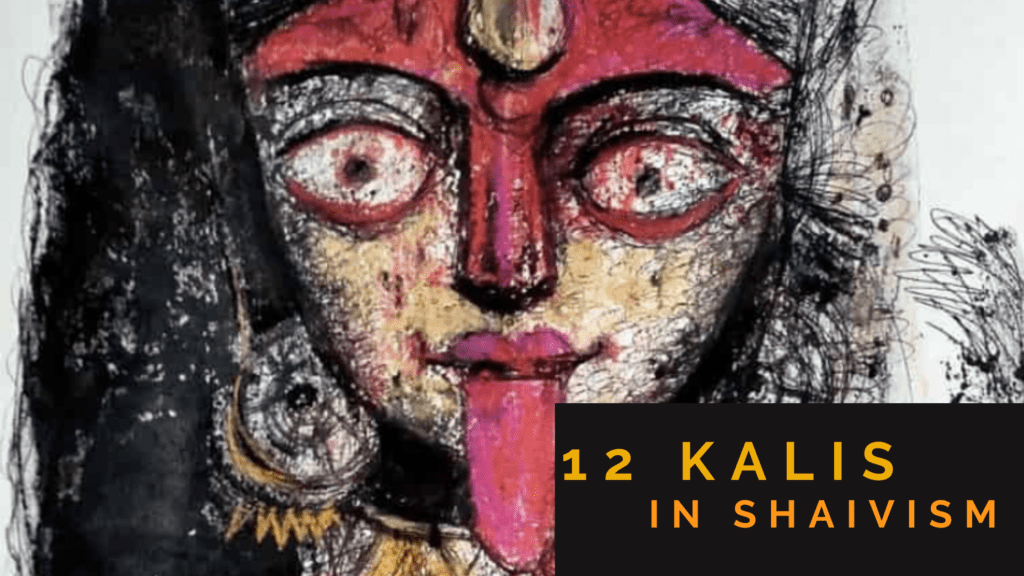
The Twelve Kālīs in Trika Tantra Shaivism: An understanding
Art By Sekhar kar
Within the intricate tapestry of Trika Tantra Shaivism, the concept of the Twelve Kālīs (Dvadasha Kali) emerges as a profound and multifaceted symbol. While often depicted as individual goddesses, the Kālīs are not distinct deities in the traditional sense, but rather personifications of the dynamic phases and processes of consciousness itself. This intricate system, deeply rooted in the Krama school of Kashmiri Shaivism, elucidates the cyclical nature of reality, the unfolding of the universe, and the transformative potential inherent within consciousness.
The Twelve Kālīs are often visualized as a wheel (Chakra), each representing a distinct stage in the continuous flux of creation, preservation, and dissolution. They embody the temporal and cyclical nature of existence, highlighting the impermanence and transformative power inherent in the universe. Each Kālī, with its unique attributes and symbolism, offers a window into the multifaceted nature of consciousness and its expression in the phenomenal world.
In the context of the Twelve Kālīs in Trika Tantra Shaivism, Kalasankarshini Kali can be understood as the overarching principle or the unifying essence that encompasses all twelve phases. She is the supreme, transcendent aspect of consciousness that underlies the entire cyclical process of creation, preservation, and dissolution.
Kalasankarshini Kali is often depicted as the “Devourer of Time,” signifying her transcendence of temporal limitations and her ability to absorb all phases of existence back into herself. She is the ultimate source and destination of all manifestation, the primordial energy from which everything arises and into which everything ultimately dissolves.
While the Twelve Kālīs represent the various stages and aspects of the cosmic cycle, Kalasankarshini Kali represents the totality, the unified whole that encompasses all these individual expressions. She is the substratum of reality, the unchanging ground of being upon which the dynamic play of creation and dissolution unfolds.
The first Kālī, Shristi-Kali, embodies the initial impulse of creation, the spark that ignites the manifestation of the universe. Rakta-Kali follows, representing the aspect of nourishment, growth, and sustenance, ensuring the continuation of the created world. Sthiti-Kali symbolizes stability, balance, and preservation, maintaining the harmonious order of existence.
Yama-Kali embodies the principle of control, regulation, and discipline, ensuring that the cosmic order is maintained. Samhara-Kali represents the destructive aspect, the force that dismantles and dissolves, making way for new beginnings. Mrtyu-Kali personifies death and dissolution, the inevitable end of all forms and the gateway to transformation.
Rudra-Kali embodies the transformative power of change, the catalyst for evolution and growth. Martanda-Kali represents the aspect of time, its relentless march, and the cyclical nature of existence. Paramarka-Kali symbolizes the transcendent aspect of consciousness, the ultimate reality that transcends all limitations and dualities.
Kalagni-Rudra-Kali represents the purifying fire, the force that burns away impurities and karmic residues, facilitating spiritual evolution. Mahabhairava-Kali embodies the dissolution of duality, the merging of subject and object into the undifferentiated unity of pure consciousness. Finally, Mahakala-Kali represents the timeless and eternal aspect of reality, transcending all limitations and constraints.
The symbolism of the Twelve Kālīs is deeply interwoven with the Tantric philosophy of Trika Shaivism, which emphasizes the non-dual nature of reality and the inherent divinity of consciousness. The Kālīs, as embodiments of the dynamic forces of consciousness, serve as powerful archetypes for spiritual seekers, offering insights into the nature of existence, the transformative potential of consciousness, and the ultimate goal of liberation (Moksha).
The worship and contemplation of the Twelve Kālīs is an integral part of the spiritual practices within the Krama school of Kashmiri Shaivism. These practices often involve the recitation of mantras, visualization of the Kālīs, and engagement in rituals designed to invoke their energies and facilitate spiritual transformation. Through these practices, practitioners seek to cultivate a deeper understanding of the cyclical nature of existence, the transformative power of consciousness, and the ultimate unity of all things.
The concept of the Twelve Kālīs, while deeply rooted in the esoteric traditions of Trika Tantra Shaivism, holds relevance for contemporary spiritual seekers as well. The symbolism of the Kālīs offers a rich framework for understanding the complexities of human experience, the challenges of life, and the potential for spiritual growth. The Kālīs, as archetypes of the dynamic forces within us, can serve as guides and allies on the path of self-discovery and transformation.
In conclusion, the Twelve Kālīs in Trika Tantra Shaivism represent a profound and multifaceted symbol that elucidates the cyclical nature of reality, the transformative power of consciousness, and the ultimate unity of all things. They serve as powerful archetypes for spiritual seekers, offering insights into the nature of existence, the challenges of life, and the potential for spiritual growth. The worship and contemplation of the Kālīs, deeply rooted in the esoteric traditions of Kashmir Shaivism, continue to inspire and guide spiritual seekers on their journey toward self-realization and liberation.
